ATCR-22
Description of the radar set, tactical-technical characteristics

Figure 1: G 14 antenna of the ATCR-22
| Specifications | |
|---|---|
| frequency: | 1 240 … 1 355 MHz
(L-Band) |
| pulse repetition time (PRT): | 1280 … 1536 µs |
| pulse repetition frequency (PRF): | 430 ± 21.5 Hz |
| pulsewidth (τ): | 3 ± 0.3 µs |
| receive time: | |
| dead time: | |
| peak power: | 1.8 MW |
| average power: | 2.25 kW |
| instrumented range: | 200 NM (≙ 370 km) |
| range resolution: | |
| accuracy: | |
| beamwidth: | 1.2° ± 0.15° |
| hits per scan: | |
| antenna rotation: | 6 rpm |
| MTBCF: | |
| MTTR: | |
ATCR-22
The ATCR-22 was an operating in L-Band en-route radar.
This radar was developed by the Selenia company on the basis of the ATCR-2TI radar in conjunction with the larger G 14 antenna. The reflector got the form of a truncated paraboloid with the dimensions of 13.7 · 6.8 m. The increase in the reflector area gave significant advantages in the antenna gain (36 … 36.5 dB). To reduce the wind load, the reflector has got a lattice structure consisting of thin tubes of aluminum. Nevertheless, this antenna was almost always used in a protecting radome. The antenna used two feed horns located in the focal plane of the reflector, to form two antenna patterns in the vertical plane. In sum, this resulted in a cosecant-squared pattern.
The synchronizer of the radar used a 6-fold staggered pulse repetition period to avoid blind speeds and ambiguous returns. The duration of the single periods was 1280 µs, 1600 µs, 1344 µs, 1536 µs, 1408 µs and 1472 µs (in this order).
The radar ATCR-22 was named PS-825 in the Royal Swedish Air Force.

